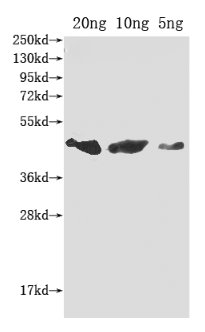The production of the polyclonal flu antibody involves several steps. First, the recombinant Escherichia coli (strain K12) flu protein (804-1039aa) is selected as the immunogen. This immunogen is injected into a rabbit. The immunogen injections are repeated several times to induce an immune response in the rabbit. After that, the B cells of the rabbit secrete a lot of antibodies, which are usually of the IgG isotype. These antibodies are collected and purified from the rabbit serum using protein G affinity chromatography. The flu antibody can react with the flu protein from Escherichia coli (strain K12). The purified flu antibody has been validated through ELISA and WB applications.
Escherichia coli flu protein (Ag43) is a phase-variable outer membrane protein crucial for autoaggregation, flocculation, and colony morphology of E. coli K12 strains [1-4]. Ag43-mediated aggregation can be macroscopically observed as the flocculation of cells in liquid suspensions [5]. Furthermore, Ag43 has been found to promote the persistence of uropathogenic E. coli isolates in the urinary tract, highlighting its significance in bacterial virulence and pathogenesis [6]. Studies have shown that Ag43 provides specific bacterial uptake and survival in human neutrophils, indicating its role in bacterial evasion of the host immune response [5].
References:
[1] M. Schembri and P. Klemm, Coordinate gene regulation by fimbriae-induced signal transduction, The Embo Journal, vol. 20, no. 12, p. 3074-3081, 2001. https://doi.org/10.1093/emboj/20.12.3074
[2] P. Klemm, L. Hjerrild, M. Gjermansen, & M. Schembri, Structure‐function analysis of the self‐recognizing antigen 43 autotransporter protein from escherichia coli, Molecular Microbiology, vol. 51, no. 1, p. 283-296, 2003. https://doi.org/10.1046/j.1365-2958.2003.03833.x
[3] G. Krisandi and S. Prayogo, Analisis potensi nanopartikel seng oksida sebagai terapi alternatif terhadap uropathogenic escherichia coli penyebab infeksi saluran kemih, Jimki Jurnal Ilmiah Mahasiswa Kedokteran Indonesia, vol. 9, no. 1, p. 38-47, 2021. https://doi.org/10.53366/jimki.v9i1.278
[4] I. Henderson, M. Meehan, & P. Owen, Antigen 43, a phase-variable bipartite outer membrane protein, determines colony morphology and autoaggregation in escherichia coli k-12, Fems Microbiology Letters, vol. 149, no. 1, p. 115-120, 2006. https://doi.org/10.1111/j.1574-6968.1997.tb10317.x
[5] S. Fexby, T. Bjarnsholt, P. Jensen, V. Roos, N. Høiby, M. Givskovet al., Biological trojan horse: antigen 43 provides specific bacterial uptake and survival in human neutrophils, Infection and Immunity, vol. 75, no. 1, p. 30-34, 2007. https://doi.org/10.1128/iai.01117-06
[6] P. Lüthje and A. Brauner, Ag43 promotes persistence of uropathogenic escherichia coli isolates in the urinary tract, Journal of Clinical Microbiology, vol. 48, no. 6, p. 2316-2317, 2010. https://doi.org/10.1128/jcm.00611-10





